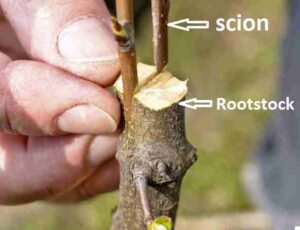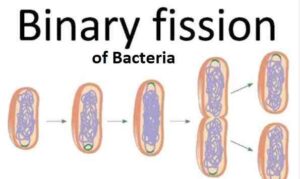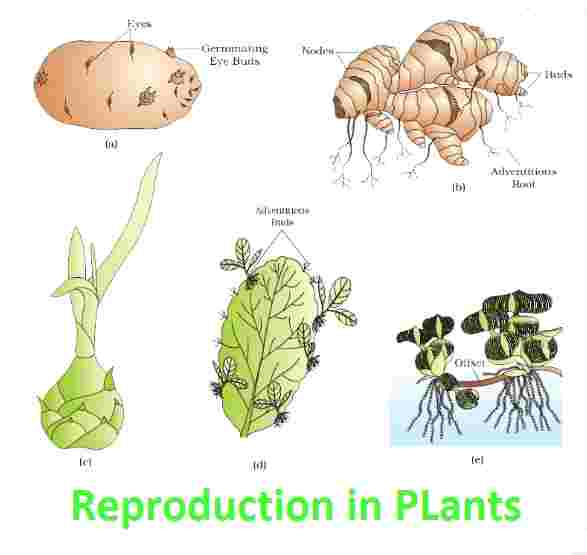Reproduction In Plants Class-8th Goyal Brothers ICSE Biology Solutions Chapter-2 Reproduction in Plants and Animals. We Provide Step by Step Answers of Objectives, Fill in the blanks , Definitions , Match the followings and Short/Long Question Type answers of Chapter-2, Unit 1, Reproduction in plants. Visit official Website CISCE for detail information about ICSE Board Class-8.
Reproduction In Plants ICSE Class-8th
Goyal Brothers Biology Solutions Chapter-2, Unit-1
| Board | ICSE |
| Class | 8th |
| Subject | Biology |
| Book Name | Goyal Brothers |
| Chapter-1 | Reproduction in Plants and Animals |
| Unit-1 | Reproduction in Plants |
| Topic | Solution of exercise questions |
| Session | 2023-24 |
Reproduction In Plants
ICSE Class-8th Goyal Brothers
I. Multiple Choice Questions. Tick(√ ) the correct choice.
1. The Common method of reproduction in bacteria is :
(a) Budding
(b) Fragmentation
(c) Binary Fission
(d) All of the above
Ans: (c) Binary Fission
2. Budding is commonly seen in
(a) Yeast
(b) Grasses
(c) Amoeba
(d) Spirogyra
And: (a) Yeast
3. Reproduction or propagation by stem is common n
(a) Begonia
(b) Potato
(c) Sweet Potato
(d) Bryophyllum
Ans: (b) Potato
II. Fill In The Blanks
- Budding is a kind of _asexual_ Reproduction.
- The amount of cytoplasm in the parent cell is _more_ then the amount in the bud.
- Yeast cells reproduce by _budding_.
- Amoeba reproduces by _binary fission_.
- Binary Fission produces cells of _equal_ size.
- Budding produces cells of _equal_ size.
- Fungi, Ferns and mosses reproduce by _spore formation_.
III. Which of the following statements are true(T) and which ones are false(F)? Mark T or F :
- Asexual reproduction is more common then the sexual reproduction. [F]
- Producing life is called respiration. [T]
- Dogs and cats reproduce from two parents. [F]
- Bacteria and yeast reproduce by sexual reproduction . [F]
- Reproduction by spores is a method of asexual reproduction. [T]
- A potato tuber is really an underground stem. [T]
- A whole new plant can grow from the eye of a tuber. [T]
- Cutting and grafting are natural means of reproduction. [F]
- Most organisms have the capacity of regeneration in some or the other way. [T]
IV. Find the odd-one out, giving reasons:
1. Gamete, budding, fragmentation, regeneration.
Reasons: Others are the sexual modes of reproduction.
2. Cutting, grafting, layering, binary fission.
Reasons: Others are the artificial method of vegetative propagation.
V. Differentiate between the following:
1. Binary fission and budding
| Binary fission | Budding |
| 1. It is a type of fission. | 1. Grafting involves the joining of two or more plants |
| 2. It is hard to identify the parent cell as it gets divided into daughter cells. | 2. The parent cell detaches from the new cell. |
| 3. The type of division is a symmetric division. | 3. The type of division is an asymmetric division. |
| 4. Examples: Bacteria and Amoeba. | 4. Examples: Hydra and Yeast. |
2. Cutting and grafting.
| Cutting | Grafting |
| 1.Only one plant is involved in cutting. | 1. It is a type of vegetative propagation. |
| 2. A section of the stem, root, or leaf is used to create a new plant. | 2. It is a method of vegetative propagation in which parts of two different plants are joined and grown to produce a new plant. |
| 3. The new plant is identical to the parent plant, with no differences. | 3. The new plant differs from the parent plants in appearance. |
| 4. Examples: Roses and sugarcane | 4. Examples: Apple and mango. |
VI. Define The following:
1. Grafting:
In grafting, the desired plant is derived from two different individuals. The root portion taken from one plant is called the stock while the stem portion from the other is called the scion. Scion is the plant which one wants to propagate and so it is grafted on to the stock. The grafting ends of the stock and scion are obliquely cut and placed face to face. Then two ends are tied tightly.

2. Vegetative Propagation:
This is an asexual method of reproduction in plants where vegetative parts, namely the root, stem or leaf, give rise to new plants. No reproductive organs take part in this method pf reproduction and, therefore, no seeds are produced.
3. Binary Fission:
It is the most common method of asexual reproduction in unicellular organisms like bacteria and Amoeba. In bacteria the single cell divides itself into almost two equal halves. Nucleus also divides into two parts. Each of the two parts then grow into full sized identical cells called the daughter cells.
4. Tissue Culture:
In this method a tissue is taken from thee tip of a plant as it is composed of undifferentiated and immature rapidly dividing cells. The tissue is grown in a suitable medium containing necessary nutrients and hormones. The tissue grows into an undifferentiated unorganized mass called callus. Small parts of this tissue are put in another medium which includes the formation of plantlets. The plantlets can be transplanted in the soil or in pots. This technique is also called micropropagation.
5. Budding:
It is commonly observed in yeast. A bulb-like projection, called the bud, is formed on the body. The nucleus of the body divides into two. Then, one of the two nuclei passes into the bud. The bud detaches itself from the parent body. It grows to fill size and becomes a new individual.
6. Regeneration:
It is a common observation that if you cut your finger, it heals. In your garden, you (cut) the grass and again next week, it needs mowing. Each organism can grow or repair itself in some or the other way. New cells grow to replace damaged or lost cells. The ability of living things to repair themselves or grow lost parts is called regeneration.
VII. Mention the common method of reproduction in the following organisms:
- Bacteria : Binary Fission
- Yeast: Budding
- Spirogyra: Fragmentation
- Mucor: Spore Formation
- Mosses: Spore Formation
- Ferns: Spore Formation
- Dahlia: Vegetative Propagation
- Potato: Vegetative Propagation
- Ginger: Vegetative Propagation
- Gladiolus: Vegetative Propagation
- Strawberry: Layering
- Rose: Cutting
- Jasmine: Layering
- Mango: Grafting
- Bougainvillea: Cutting.
VIII. Answer the following questions :
Question 1 :- Why is reproduction necessary for living organisms?
Answer: Reproduction is one of the most important properties of Living organisms. It means creating new life – producing young ones of their own kind. Therefore it is the means of perpetuation or continuation of species.
Question 2 :- Describe the advantages of vegetative reproduction.
Answer: The advantages of vegetative propagation are :-
(a) It is an easier, rapid and less expensive method of propagation.
(b) Seedless plants can be raised.
(c) Plants produced by this method are identical copies of the parent plant and show no variations.
(d) Plants like banana, sugarcane, sweet potato, rose and jasmine do not produce viable seeds. Such plants can be easily grown by this method.
Question 3 :- Describe the various methods of vegetative reproduction.
Answer: Various methods of vegetative propagation are :-
(a) Vegetative propagation by roots: New plants arise from the swollen roots buried in the soil.
Example: Sweet potato and dahlia
(b) Vegetative propagation by Underground Stems: A number of plants multiply by stems or their modification.
Example: Ginger and sugarcane
(c) Vegetative propagation by Aerial Stems: Axillary buds which are present on the nodes of stem grow into new plants.
Example: Strawberry
(d) Vegetative propagation by Leaves: Some plants can be propagated by leaves, plantlets develop from the margins of intact leaves. These plantlets, on being detached, develop into independent plants.
Example: Bryophyllum and Begonia
Question 4 :- Explain the process of binary fission in bacteria.
Answer: Binary fission is the most common method of asexual reproduction in unicellular organisms like bacteria and Amoeba. In bacteria the single cell divides itself into almost two equal halves. Nucleus also divides into two parts. Each of the two parts then grows into full sized identical.

— : end of Reproduction in Plants Class-8th Goyal Brothers:–
Return to- ICSE Class -8 Goyal Brothers Biology Solutions
Thanks.
Please share with your friends if you find it useful.




